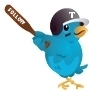Honey bees are an excellent animal to study with regards to behavior because they are abundant and familiar to most people. An animal that is disregarded every day has very specific behaviors that go unnoticed by the normal person. Karl von Frisch studied the behavior of honey bees with regards to communication and was awarded the Nobel Prize for physiology and medicine in 1973. Von Frisch noticed that honey bees communicate with the language of dance. Honey bees are able to direct other bees to food sources through the round dance and the waggle dance. The round dance tells the other foragers that food is within 50 meters of the hive, but it does not provide much information regarding direction. The waggle dance, which may be vertical or horizontal, provides more detail about both the distance and the direction of the located food source. It is also hypothesized that the bees rely on their olfactory sense to help locate the food source once the foragers are given directions from the dances.
Another signal for communication is the shaking signal, also known as the jerking dance, vibration dance, or vibration signal. It is a modulatory communication signal because it appears to manipulate the overall arousal or activity of behaviors. The shaking signal is most common in worker communication, but it is also evident in reproductive swarming. A worker bee vibrates its body dorsoventrally while holding another honey bee with its front legs. Jacobus Biesmeijer examined the incidence of shaking signals in a forager’s life and the conditions that led to its performance to investigate why the shaking signal is used in communication for food sources. Biesmeijer found that the experienced foragers executed 92.1% of the observed shaking signals. He also observed that 64% of the shaking signals were executed by experienced foragers after they had discovered a food source. About 71% of the shaking signal sessions occurred after the first five foraging success within one day. Then other communication signals, such as the waggle dance, were performed more often after the first five successes. Biesmeijer proved that most shakers are foragers and that the shaking signal is most often executed by foraging bees over pre-foraging bees. Beismeijer concluded that the shaking signal presents the overall message of transfer work for various activities or activity levels. Sometimes the signal serves to increase activity, when bees shake inactive bees. At other times, the signal serves as an inhibitory mechanism such as the shaking signal at the end of the day. However, the shaking signal is preferentially directed towards inactive bees. All three types of communication between honey bees are effective in their jobs with regards to foraging and task managing.
- “The general story of the communication of the distance, the situation, and the direction of a food source by the dances of the returning (honey bee) worker bee on the vertical comb of the hive, has been known in general outline from the work of Karl von Frisch in the middle 1950s.”




